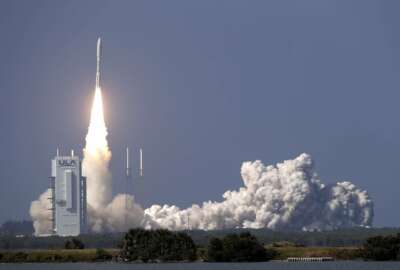
DoD postures itself to make space more of a warfighting domain, establish dominance
The Defense Department released a strategy outlining how it will keep its edge in space.
The Defense Department is posturing itself to further weaponize space and establish it as a warfighting domain with a new strategy, which the Pentagon says is focused on parrying threats and establishing dominance outside the earth’s atmosphere.
The space strategy functions much like DoD’s well-established National Defense Strategy (NDS), which is aimed at bringing the military into the next era of warfighting. Like the NDS, the space strategy puts an emphasis on modernization, joint operations and building alliances.
“The enterprise we created in the past was a support function — we are going to launch these satellites and they are going to be there for us. We were not fully steeped in the whole element of building our forces as well as employing our forces for conflict into the domain,” DoD Deputy Assistant Secretary for Space Policy Stephen Kitay said Wednesday at the Pentagon. “That’s this transformation that’s happening right now, and we have this unique, unique moment right now where we are standing up the Space Force, Space Command, Space Development Agency.”
The strategy focuses on four lines of effort:
- Building a military advantage in space
- Integrating military spacepower into operations
- Shaping the strategic environment and
- Cooperating with allies, partners, industry and others
Building out the military’s advantage involves continuing to beef up the Space Force. But it also involves developing and documenting doctrinal foundations for military spacepower and expanding space warfighting expertise and culture.
“DoD will develop an agile space enterprise that can take advantage of emerging technological and commercial innovation in order to continually outpace adversary threats,” the authors of the strategy state. “Space superiority will be achieved through on-orbit, multidomain, and cross-component operations that are fully integrated with our allies and partners.”
Integrating that spacepower falls on U.S. Space Command, which will plan, exercise, and execute operations across the services and spectrum of conflict.
DoD will also integrate space operations, intelligence capabilities and personnel into its plans and staff.
In order to shape the strategic environment DoD says it will “partner with the Department of State to work closely with allies and partners in order to develop common understandings of appropriate behavior in space. The United States must align with allies and partners to engage proactively and assertively with the wider international community, including with potential adversaries, to advance U.S., allied, and partner national security interests and to reduce the possibility of mishaps and misperceptions.”
That involves bettering space messaging, promoting standards and norms and deterring aggression.
Kitay said that aggression and the threat that is leading to the militarization of space comes from adversaries like China and Russia using space to interfere with U.S. interests and technologies.
“It is clear that they have weaponized space,” Kitay said. “In 2017, there was a main Russia satellite. Out of that satellite, a smaller satellite was birthed from that main satellite. From that smaller satellite a projectile was launched. They said this was an inspector satellite.”
The U.S. State Department said it looked nothing like an inspector satellite and looked like something much more concerning.
Russia has also been pointing fingers. In late 2019, Russian leader Vladimir Putin said he was concerned about the United States and NATO’s acceleration of space forces. He added that Russia is paying more attention to its space and rocket industry as a result.
In April, Russia tested a missile capable of destroying low-earth satellites.
Copyright © 2025 Federal News Network. All rights reserved. This website is not intended for users located within the European Economic Area.
Scott Maucione is a defense reporter for Federal News Network and reports on human capital, workforce and the Defense Department at-large.
Follow @smaucioneWFED






